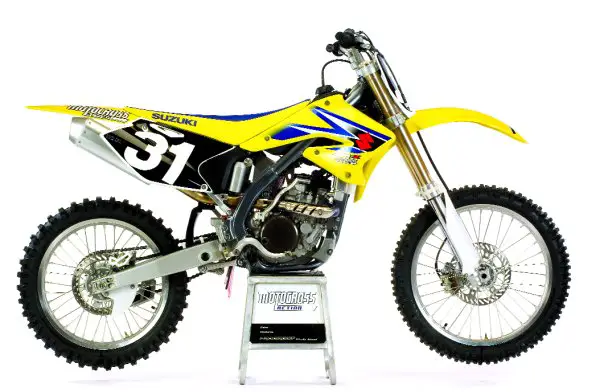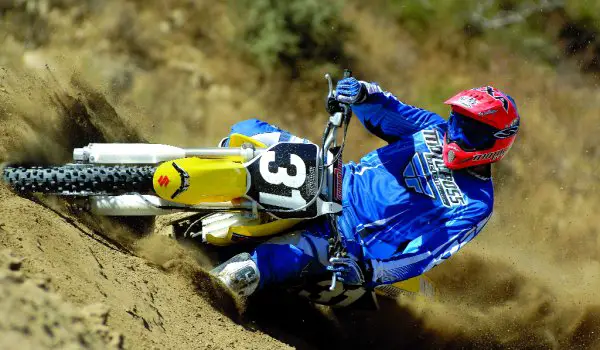MXA’S 2006 RM-Z250 TEST
You’ve probably heard this story before, but we need to tell it as part of the background on MXA’s 2006 Suzuki RM-Z250 test. On August 29, 2002, Kawasaki President Masamoto Tazaki announced that Kawasaki and Suzuki were forming an alliance. The Kawasaki/Suzuki alliance is all about filling in product lines (by sharing machines) and lowering costs (by doubling their ordering capability for standard-issue parts).
In the first few years of the alliance, Kawasaki and Suzuki shared a large number of bikes between them, including the KX65, KLX110, DR125 and DRZ400. The alliance allowed the two small motorcycle companies (when compared to Honda and Yamaha) to be able to market a full line of bikes without having to invest double the money in their development. The alliance gave Suzuki and Kawasaki purchasing power to keep costs down and an instant broadening of their product line.

The first high-profile cooperative effort of the alliance was the 2004 Kawasaki KX250F (nee’ Suzuki RM-Z250). Suzuki provided the engine blueprints, while Kawasaki handled the chassis and production issues. From a marketing point of view, the RM-Z/KX-F was a success. It outsold the RM125 and KX125 two-strokes, and neither company had to foot the R&D bill alone. The KX250F/RM-Z250 partnership held through the 2005 model year. And for 2006, Kawasaki had a new aluminum frame on the drawing boards, along with some hopped-up engine mods.
But there was a problem. Suzuki had been working on their own RM-Z250although it wouldn’t be ready until the 2007 model year. Suzuki needed Kawasaki to supply them with a bike in the interim 2006 season. Kawasaki was reluctant to give Suzuki its new aluminum-framed KX250F, unless Suzuki would commit to a two-year deal. Suzuki wanted a one-year deal so that they would be free to introduce their own bike in ?07. In the end, Kawasaki elected to go it alone with the alloy KX250F and instead agreed to provide Suzuki with a mildly modified version of the 2005 RM-Z250 for 2006.
In a business decision, Suzuki decided to bite the bullet and take the old-school RM-Z250 in order to be free to introduce their own in-house bike in 2007.
Q:IS THE 2006 RM-Z250 ENGINE IDENTICAL TO THE 2005 RM-Z250 ENGINE?
A:No. There are some differences between the engines. Although Kawasaki kept most of the performance mods for themselves, they did give Suzuki the durability mods. These include not only new center cases and an enlarged oil pump, but new oil galleys to lubricate the top end. These are valuable additions to the RM-Z250 powerplant.
Although the RM-Z250 engine was designed by Suzuki?s engineers, it is built in Kawasaki’s factory. At the start of the alliance this didn’t seem like a problem, but over the long haul it turned out to be. Since Suzuki didn’t build the engine, there was no ready-supply of works parts for their race team’s bikes. Additionally, all future development of the engine was out of Suzuki’s handsresulting in Kawasaki getting a new, improved engine spec for 2006 and Suzuki being left with the same performance package as in 2005.
Q:IS THE 2006 SUZUKI RM-Z250 FASTER THAN THE 2005 RM-Z250?
A:No. It is about the sameperhaps a hair better because of more rigidity in the castings and better oiling of a top-end mechanism, but nothing quantitative.
Q:IS THE 2006 RM-Z250 ENGINE ANTIQUATED?
A:No. This is a good powerplant. It pumps out competitive power in an easy-to-use form. Every MXA test rider liked the powerband of the 2005 RM-Z250, and we feel the same about the 2006 model.

Q:ARE THERE BETTER ENGINES ON THE TRACK THAN THE ?06 RM-Z250?
A:Yes. Kawasaki knew what they were doing when they asked for a two-year contract out of Suzuki. The ?06 KX250F version of the RM-Z250 engine is better, more powerful and considerably more impressive than the ?05 spec. The KX250F has, in our opinion, the best 250 four-stroke engine of 2006. Unfortunately, the 2006 RM-Z250 engine isn’t as good as the KX250F enginewhich means it finds itself much lower in the powerband rankings than the conjoined twin that it was surgically separated from this season.
Don’t get us wrong. The engine is the best part of the 2006 RM-Z250, and no MXA test riders are whining about having to race the RM-Z250 powerplant. It’s a good engine. It’s just not a great engine.
Q:IS THE 2006 SUZUKI RM-Z250 MORE RELIABLE?
A:You bet. Engine reliability has come a long way since the first KX-F/RM-Z was introduced in 2004. Engine overheating, caused by both coolant and lubrication shortcomings, has been addressed since year one. Suzuki, via Kawasaki, also seems to have gotten a handle on the tranny and valve bucket problems of the past.
The only problem that still vexes the MXA test crew is valve float. We solve this on our own with stiffer Pro Circuit valve springs.
Q:HOW GOOD IS THE 2006 SUZUKI RM-Z250 SUSPENSION?
A:You don’t have to be Sherlock Holmes to conclude that the 2006 RM-Z250’s suspension settings are whack. No surprise here, since suspension mods were not on the factory’s update agenda for 2006. To tell the truth, they weren’t on the honey-do list in 2005 either. No bike can expect to be at the top of its game in this competitive marketplace with three-year-old suspension components. The RM-Z250 is unbalanced. It stinkbugged in 2004; it stinkbugged in 2005; and it still stinkbugs in 2006.
Forks: The old-school Kayaba units can handle big hits and little bumps without any major complaints, but they roll off the assembly line too far down in the clamps. As the bike sits on the showroom floor, the rear is high and the front is low. Our quick fix was to run the fork cap flush with the top triple clamp and dial in 105mm of race sag in the rear shock.
We ran the forks as stiff as we could stand them on compression (approximately six clicks out) and the shock as soft as we could go (approximately 15 out).
Shock: The stock shock setup is way off the mark. It is over-damped and mated to a poor rising rateit has a tendency to kick in the bumps and overload the forks in every off-throttle situation. Thankfully, Pro Circuit sells the works linkage that they use on the National Championship-winning bikes of Langston and Tedesco. The Pro Circuit linkage helps balance the bike out and soften the rear suspension.
Q:HOW DOES THE RM-Z250 HANDLE?
A:Suzuki has the most accurate handling on the face of the Earth. The typical Suzuki carves the inside of a corner faster than Renee Zellweger goes through husbands. Nothing turns as great as a Suzuki. But, and this is the big but, the RM-Z250 is not a Suzuki. If you remember correctly, we told you at the beginning that Suzuki’s contribution to the RM-Z250 was engine designKawasaki was responsible for the chassis.
If you expect the RM-Z250 to feel like the little brother of the RM-Z450, you will be disappointed. It does not handle like a Suzuki. It handles like a Kawasaki. Believe us when we say that we wish it handled like a Suzuki, because, as it sits, the RM-Z250’s handling is an acquired taste. The 2006 RM-Z250 likes to be kept upright in the corners, maneuvered with copious handlebar input and throttle steered around the second half of the corner. It has the irritating habit of standing up in the corners when laid over.
Q:WHAT DID WE HATE?
A: The hate list:
(1) Handlebars: Museum pieces. They are steel.
(2) Rear suspension: This should have been fixed in 2004 or 2005. It’s not a little off, it is way off.
(3) Handling: If you like the front to hang down and the rear to ride high, you’ll love the handling of the RM-Z250. Small riders will pay the biggest penalty.
(4) Vibration: The RM-Z250 doesn’t have a counterbalancer. We didn’t need a spec sheet to find this out. We could feel it at high rpm.
(5) Gearing: Add a tooth to the rear or you’ll be dogging it out of corners.
Q:WHAT DID WE LIKE?
A: The like list:
(1) Engine: We liked the power. This is a competitive engine. It’s fun to ride and very manageable.
Q:WHAT DO WE REALLY THINK?
A:Consider the 2006 Suzuki RM-Z250 the end result of a business deal gone badthen decide if you want to be the party of the third-part.
For more 2006 Bike Tests go to Top Ten Stories





Comments are closed.